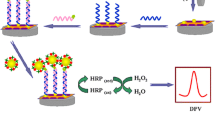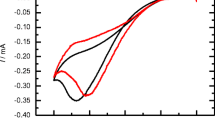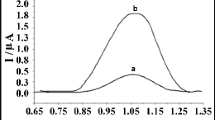Abstract
A new approach for a simple electrochemical detection of PAT gene fragment is described. Poly(2,6-pyridinedicarboxylic acid) (PDC) modified glassy carbon electrode (GCE) was prepared by potential scan electropolymerization in an aqueous solution. Mg2+ ions were incorporated by immersion of the modified electrode in 0.5 mol/L aqueous solution of MgCl2 to complete the preparation of a generic “activated” electrode ready for binding the probe DNA. The ssDNA was linked to the conducting polymer by forming a bidentate complex between the carboxyl groups on the polymer and the phosphate groups of DNA via Mg2+. DNA immobilization and hybridization were characterized with differential pulse voltammetry (DPV) by using methylene blue (MB) as indicator and electrochemical impedance spectroscopy (EIS). The EIS was of higher sensitivity for DNA detection as compared with voltammetric methods in our strategy. The electron transfer resistance (R et) of the electrode surface in EIS in [Fe(CN)6]3−/4− solution increased after the immobilization of the DNA probe on the Mg/PDC/GCE electrode. The hybridization of the DNA probe with complementary DNA (cDNA) made R et increase further. The difference between the R et at ssDNA/Mg/PDC/GCE and that at hybridization DNA modified electrode (dsDNA/Mg/PDC/GCE) was applied to determine the specific sequence related to the target PAT gene with the dynamic range comprised between 1.0 × 10−9 and 1.0 × 10−5 mol/L. A detection limit of 3.4 × 10−10 mol/L of oligonucleotides can be estimated.
Similar content being viewed by others
References
Vidal J C, Esperanza G R, Castillo J R. Recent advances in electropolymerized conducting polymers in amperometric biosensors. Microchim Acta, 2003, 143: 93–111
Li L L, Cai H, Lee T M, Barford J, Hsing I M. Electrochemical detection of PCR amplicons using electroconductive polymer modified electrode and multiple nanoparticle labels. Electroanalysis, 2004, 16: 81–84
Wang J, Bard A J. Monitoring DNA immobilization and hybridization on surfaces by atomic force microscopy force measurements. Anal Chem, 2001, 73: 2207–2212
Thompson L A, Kowalik J, Josowicz M, Janata J. Label-free DNA hybridization probe based on a conducting polymer. J Am Chem Soc, 2003, 125: 324–325
Ren Y, Jiao K, Xu G Y. An electrochemical DNA sensor based on electrodepositing aluminum ion films on stearic acid-modified carbon paste electrode and its application for the detection of specific sequences related to bargene and CP4 epsps gene. Electroanalysis, 2005, 17: 2182–2189
Yang M H, Li C X, Yang Y H, et al. Hydrogen peroxide biosensor based on enzyme multiplayer through electrostatic adsorption. Acta Chim Sinica (in Chinese), 2004, 62: 502–507
Li C X, Yang M H, Shen G L, et al. Hydrogen peroxide biosensor based on nano-Au colloid immobilized on 2,6-pyridinedicarboxylic acid polymer. Acta Chim Sinica (in Chinese), 2004, 62: 1663–1667
Erdem A, Kerman K, Meric B, Qzsoz M. Methylene blue as a novel electrochemical hybridization indicator. Electroanalysis, 2001, 13(3): 219–223
Kerman K, Ozsoz D, Kara P, Meric B, Gooding J J, Ozsoz M. Voltammetric determination of DNA hybridization using methylene blue and self-assembled alkanethiol monolayer on gold electrodes. Anal Chim Acta, 2002, 462: 39–47
Cai H, Xu Y, He P G, Fang Y Z. Indicator free DNA hybridization detection by impedance measurement based on the DNA-doped conducting polymer film formed on the carbon nanotube modified electrode. Electroanalysis, 2003, 15: 1864–1870
Xu Y, Jiang Y, Cai H, He P G, Fang Y Z. Electrochemical impedance detection of DNA hybridization based on the formation of M-DNA on polypyrrole/carbon nanotube modified electrode. Anal Chim Acta, 2004, 516: 19–27
Xu D, Xu D W, Yu X B, Liu Z H, He W, Ma Z Q. Label-free electrochemical detection for aptamer-based array electrodes. Anal Chem, 2005, 77: 5107–5113
Pan S, Rothberg L. Chemical control of electro de functionalization for detection of DNA hybridization by electrochemical impedance spectroscopy. Langmuir, 2005, 21: 1022–1027
Author information
Authors and Affiliations
Corresponding author
Additional information
Supported by the National Natural Science Foundation of China (Grant Nos. 20635020 and 20375020), Doctoral Foundation of the Ministry of Education of China (Grant No. 20060426001) and the Natural Science Foundation of Qingdao City (Grant No. 04-2-JZP-8)
Rights and permissions
About this article
Cite this article
Jiao, K., Yang, T., Yang, J. et al. Immobilization and hybridization of DNA based on magnesium ion modified 2,6-pyridinedicarboxylic acid polymer and its application for label-free PAT gene fragment detection by electrochemical impedance spectroscopy. SCI CHINA SER B 50, 538–546 (2007). https://doi.org/10.1007/s11426-007-0034-8
Received:
Accepted:
Issue Date:
DOI: https://doi.org/10.1007/s11426-007-0034-8




